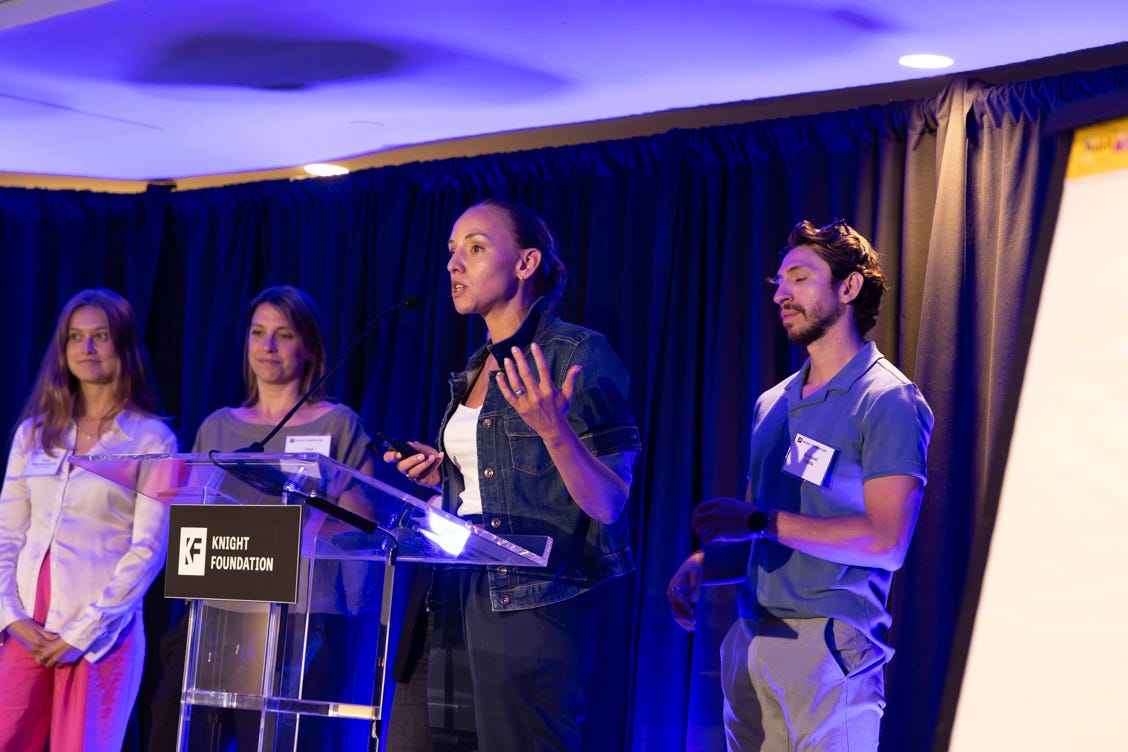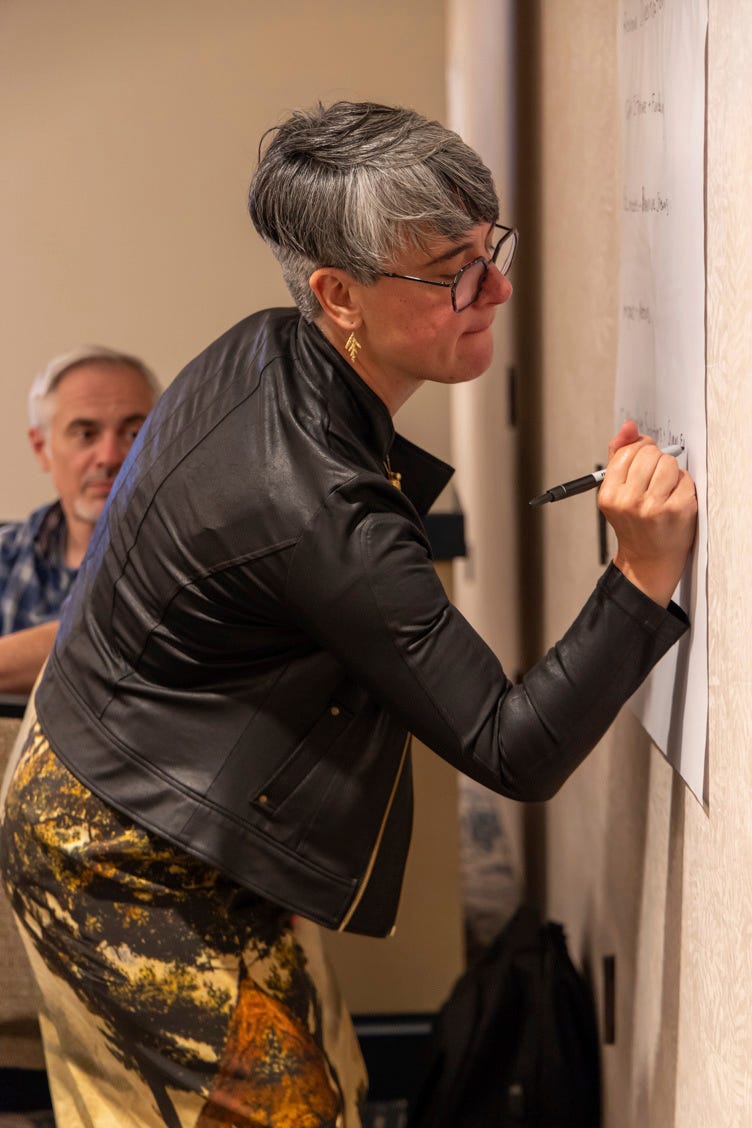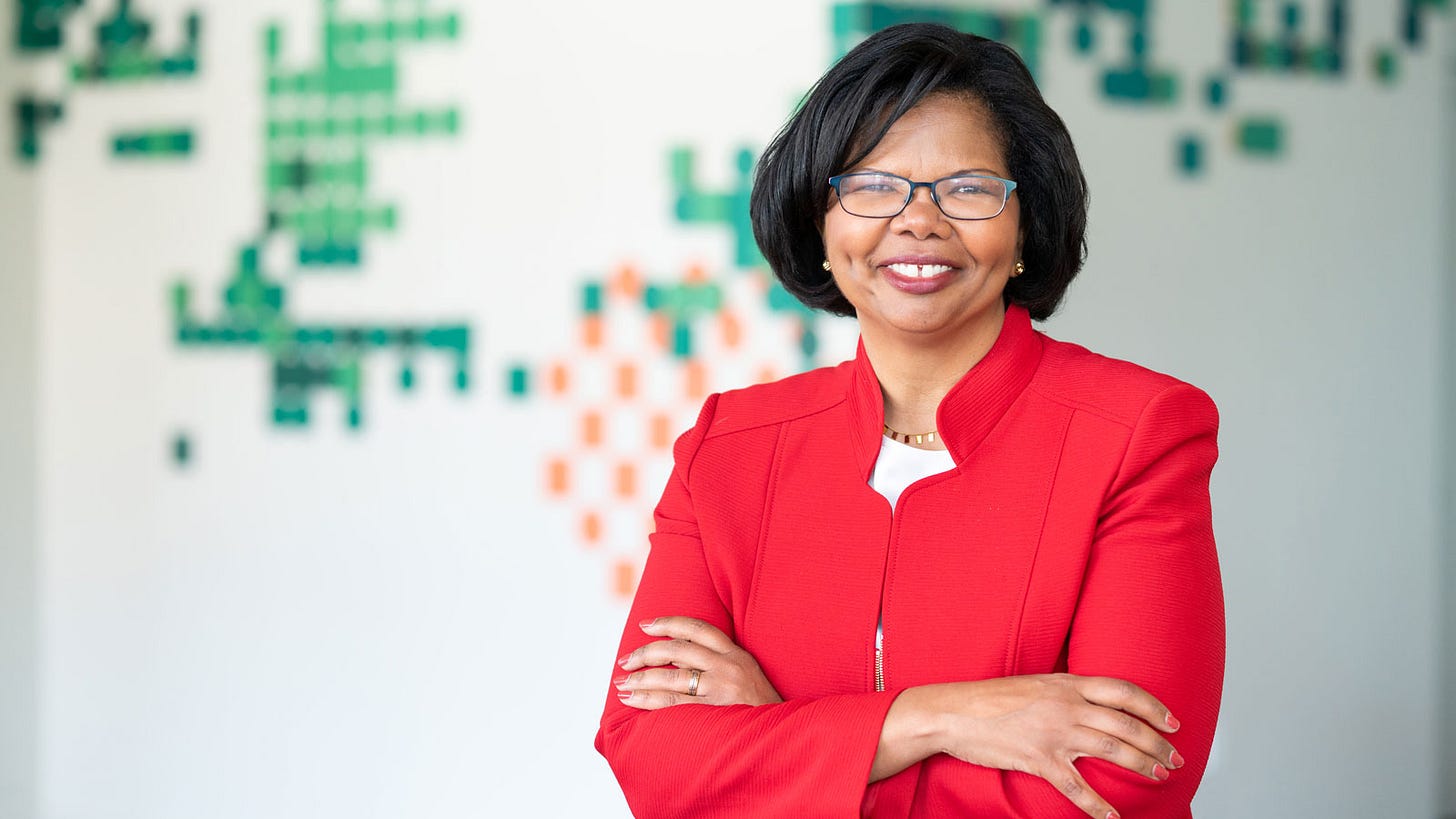Local news infrastructure summit focuses on “bold bets”
Forty leaders came together in Miami to discuss building long-term infrastructure for news

How can we define overall success for local journalism over the next handful of years? And what’s one specific bold bet that can get us there?
We posed these two provocations to 40 local news leaders—publishers, solutions providers, funders and academics—to kick off our infrastructure summit in Miami a few weeks ago.
There are many ways to approach each question. On the success front, some chose to focus on the industry, with answers such as “doubling the number of journalists in local news.” Others focused on the consumer, stating things like, “a majority of residents in every community having access to news and info they trust.” Everyone had a unique take.
There’s no single perfect answer, but thanks to some real-time sense-making work by Knight and Press Forward interns, we quickly coalesced around four themes we captured as statements of desire:
Make us smart(er): Develop and retain the talent to properly serve communities.
Make us rich(er): Increase publisher revenue to sustainable levels.
Make us collaborat(ors): Optimize shared services to close gaps and reduce duplication.
Make us essential: Help audiences deepen their relationships with publishers.
With those themes in place, we broke into four teams of 10. We provided comically loose guidance, to the effect of, “come back tomorrow with a great presentation,” and sent folks off to breakout rooms. Each team spent the next six hours hashing out big ideas and tangible first/next steps. One group even delayed their happy hour to finish up, a rare (and possibly illegal) occurrence in journalism. Another papered over their windows to prevent their big reveal from leaking. (Okay, it was the same group.)
On the second day, each team presented their work back to the full room.
Make us smart(er) rallied around a concept to bring more than 1,000 new leaders into the local news ecosystem.
Make us rich(er) identified top revenue opportunities for small, medium and large publishers, by both digging into traditional spaces such as advertising and adapting strategies from other fields such as real estate.
Make us collaborat(ors) focused on three areas where shared service providers can come together: premium ad networks, shared resource guides and fractionalized expert resources.
Make us essential organized ideas into a marketing funnel of sorts and staked out a few opportunities to pursue, including guerrilla marketing and community-centered reporting.
Each group uncovered a number of possibilities worth exploring further, and we wrapped the summit after some closing thoughts and reflections.
A few other takeaways:
Few of these ideas are truly novel. Some have been circulating in our industry for years, while others already exist in adjacent industries and are ripe for adaptation. That’s a good thing! The work ahead is more likely a matter of assembly than pure invention.
It takes time to step out of your own organizational mindset, but it’s valuable because there are fruitful opportunities between and beyond the things that already exist.
Even though there’s a seemingly endless traveling circus of journalism conferences, a number of participants made new and valuable connections, which speaks to the need to structure more convenings like this.
We should be clear about the scale of ambition at which we want to operate. The number of people, organizations and dollars required to serve every community in the U.S. likely all have more zeroes than we usually talk about.
As Erin Millar of Indiegraf told us after the summit: “The challenge and opportunity is to catalyze collaboration across the industry to adapt, develop and create strategies that work for the majority of news deserts so that the exciting investments being made in local news don't exacerbate news inequity.”
And Stephanie Campbell of The Beacon said, “Our discussions on marketing and resources are just the beginning. I know we have a top-of-funnel problem [getting people into the membership journey] at The Beacon, and now I'm convinced this is a national challenge."
Where do we go from here? We’ve all had that experience of in-the-room enthusiasm deflating like a mylar balloon in the weeks following an event. We’re doing two things to counter that:
We’re looking to make specific grants to propel some of the ideas presented during the event. Some things don’t need more talk; it’s time to act.
We’re looking for someone to coordinate and build upon this effort to keep things going. Is it you? Someone you know? More details here.
Other news around the horn…
Investments
🧑🏽🎓 Student reporting gets a boost with $7 million for CCN. The Center for Community News (CCN) at the University of Vermont has a simple theory of change: News deserts are bad. They happen to be located near universities around the country. So, universities can train student journalists to cover local communities in news deserts. They have been mapping the situation with newsroom/academic partnerships (see map above) while helping more schools develop student newsrooms and partnerships with local news outlets. Now they have more fuel to add to the fire, with $7 million in new funding, including $5 million from Knight Foundation and the rest from MacArthur Foundation and the University of Vermont. CCN has already learned that students should be central to these efforts, college faculty and administration are key to success, and collaborations are vital. “CCN was established to ensure that no university-led reporting program was operating in isolation; to forge connections and collaborations across schools; to identify best practices and share wisdom; and to create a common set of resources,” wrote Richard Watts, director of CCN. “In the coming years, we will continue to lead our strong statehouse cohort and to add new ones in areas that show great promise.”
💰Associated Press raising $100 million to support local news. Press Forward is famously raising more than $500 million to support local news, but we all know that’s not enough. The AP decided to take action, setting up a sister nonprofit called The AP Fund for Journalism, with the intention of raising $100 million to support the AP’s efforts and others who are expanding state and local news around the country. The AP is getting less revenue from licensing fees from a shrinking news industry and has been raising increasing amounts of money from philanthropy, more than $61 million over the past seven years, according to CJR. This new fund will enable the AP to raise more money and invest in services to support newsrooms, such as AI tools or data journalism. “There’s just a very clear need for more news, and I would say high-quality, nonpartisan, independent news,” AP executive editor Julie Pace told CJR. “We’re going to try to raise money to address exactly this crisis.”
🔔 Philly media, community groups get $2.85 million in civic info grants. The Every Voice, Every Vote project was so successful last year during Philadelphia municipal elections that the Lenfest Institute and a coalition of funders (including Knight) decided to up the ante and give 71 news outlets and community groups $2.85 million in grants to expand access to civic news. The project included 130 media, community and social media partners in 2023 who created more than 365 civic engagement projects and 600 pieces of journalism, along with 38 candidate forums and resources in 15 languages. The new grants range from $10,000 to $130,000 to support community-centered projects that will run from July 2024 to December 2025, with a priority on “solutions-focused accountability reporting” and civic engagement. “As we build on the momentum of the first round of Every Voice, Every Vote, we are again seeking to engage Philadelphians in every neighborhood across the city to ensure that their voices are heard and the issues that they most care about are being addressed,” said Lenfest Institute’s head of Philadelphia programs Shawn Mooring.
Research

🌎 Global survey of funders delves into motivations, challenges. Foundation funding for journalism has been heavily focused on North America, supporting trustworthy news and fighting misinformation, and it’s risen in the past five years. Those are the top-line findings of a recent global survey by Media Impact Funders. The foundations surveyed faced many challenges in funding journalism, including scaling to meet grantee needs and making the case for journalism funding internally (see more in the chart above). Despite the challenges, 87 percent of funders were optimistic about philanthropy’s chance to make an impact in the field. One striking finding was that funders were much more interested in supporting civic engagement (70 percent) than protecting the safety of journalists (17 percent). A separate look at the top 25 funders in the survey (including Knight) showed that they had given $1.1 billion to journalism grantees from 2018 to 2022, with funding peaking in the COVID-19 year of 2020 but remaining higher than 2019 levels in 2022. “We can see from this data that funders in the space are activated, and funds are flowing to journalism recipients. However, it’s difficult to draw firm conclusions from a limited dataset [for the top 25 funders] that is primarily focused on funders in the United States,” the report concludes.
Disclosure: Dot Connector Studio, which helps produce this newsletter, also led this research project for MIF.
🤷🏽♀️ Figuring out what the youngs want from a news experience. For so long, news publishers have anguished over their toughest audience to reach: young people. The latest to read the tea leaves are researchers at Knight Lab at Northwestern and FT Strategies (funded by Google News Initiative) who released the report “Next Gen News: Understanding the Audiences of 2030.” They interviewed 45 folks ages 18 to 25 from Nigeria, India and the U.S. along with 19 industry experts with “deep knowledge.” They found that young people are inundated with information inputs (as shown above) and then have to sift through the noise. What they’re looking for is a trusted source with an affinity for their needs, and information presented with a “transparency of intention.” As expected, one of the report’s solutions for publishers include partnering with creators or elevating individual journalists. They also recommend more customized news feeds, mimicking social media experiences, modernizing language (FTW), catering to different modes of consumption, and giving hope and empowering action. Finally, the Rosetta Stone for young people!
Policy
💸 California Senate passes bill to take billions from big tech to give to local news. California State Sen. Steve Glazer (D-Orinda) is truly our modern-day Robin Hood. His bill, SB 1327, would impose a “data extraction mitigation fee” on tech companies such as Meta, Amazon and Google to fund local news. Just how big is Glazer going? Fees from the tax would provide $500 million annually in employment tax credits to news outlets in the Golden State, with $400 million more going to schools and fellowships. “California already imposes mitigation fees on companies that put chemicals into the environment,” said Glazer in support of the bill. “In the same way, the fee in my bill assigns the cost of reviving local journalism to those firms whose data extraction and economic activity is causing the news industry’s decline.” Not surprisingly, many Republicans, business interests and the tech firms are opposed to the ambitious bill. Rebuild Local News honcho Steve Waldman was exultant about the bill’s progress: “While further negotiations with various stakeholders are expected, this decisive action sends a powerful message: something must be done, and major tech companies must be part of the solution.”
Jobs
American Journalism Project, Head of Emerging Markets
Learn more here.
MLK50: Justice Through Journalism, Co-Executive Director
Learn more here.
Investigate Midwest, Editor in Chief
Learn more here.
New Bedford Light, Executive Editor
Learn more here.
The Trace, Director of Development
Learn more here.
Fellowships
Chauncey Bailey Journalist of Color Investigative Reporting Fellowship
IRE
Investigative program with stipends for travel
Apply by September 21
$12,000 stipend for 10 months
May 2024 to March 2025
Local Investigations Fellowship
New York Times
One year; fellows stay in their newsrooms
Apply by September 2
Trainings
Poynter
Free with code and online
July 11 at 1 pm ET
Should news organizations date AI companies?
Hacks/Hackers
Free and online
July 23 at noon ET
Revenue generation for publishers: Aligning profit with purpose
Indiegraf and Amanda Zamora
Free and online
July 25 at noon ET
Upcoming Events 📅
Report for America Presents: Growing Statewide Support for Local News in Minnesota
Minneapolis
July 18
Oklahoma City
July 25–27
National Association of Black Journalists (NABJ)
Chicago
July 31–August 4
Minneapolis
August 15–16
LION’s Independent News Sustainability Summit
Chicago
September 5–7
The Association for LGTBQ+ Journalists
Los Angeles
September 5–8
Journalism Women & Symposium (JAWS) CAMP
September 13–15
New Orleans
Online News Association (ONA24)
Atlanta
September 18–21
Local Media Association (LMA) Fest
Chicago
September 24–25
News Product Alliance (NPA) Summit
Online
October 11
JFunders: Journalism Funders Gathering
San Francisco
October 22–23
Quote of the Week
“By the end of our first year, with anticipated additional aligned funds being awarded, we project that we will invest more than $100 million in local news efforts across the country. The bulk, $60 million-plus, is moved through Aligned Grantmaking, while the Pooled Fund will invest $20 million before the end of 2024 and our Locals are just getting started.”
—Dale Anglin, director of Press Forward, in an Interim Report
News @ Knight Credits
Written by Marc Lavallee, with Mark Glaser
Edited by Jim Brady, Jessica Clark and Kara Pickman








